|
Nemertean, Proboscis or Ribbon Worms FAQs
Related FAQs: Worm Diversity FAQs, FAQs 2,
FAQs 3, & Worm IDs
1, Worm IDs
2, Worm IDs 3, Worm IDs 4,
Worm IDs 5, Worm IDs 6, Worm
IDs 7, Worm IDs 8, & Worm ID
FAQs by Group/Phylum: Flatworm
Identification ID, Nematode,
Roundworm ID, Nematomorpha, Horsehair Worm ID,
Acanthocephalans,
Thorny-headed Worm ID, Polychaete Identification, Polychaete ID 2, Tubeworm ID, Hirudineans, Leech ID, Sipunculids, Peanut Worm ID, Echiuran Worm ID,
Related Articles: Worms,
Polychaetes, Flatworms/Planaria,
|
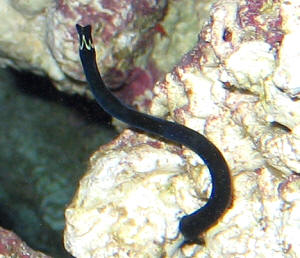
|
Baseodiscus mexicanus
12/25/16
Hello Bob and crew and merry Christmas!
<And to you/for you/rs>
While wandering around a few of my local aquarium stores today I
stumbled across something I'd only seen in pictures, a Ribbon worm. I've
always been intrigued by them, but have been put off by the lack of
information surrounding their care. I'd love to add this specimen to my
aquarium, but I'm afraid it might go after my fish or my shrimp. The
worm in question is Baseodiscus mexicanus, and was roughly 20' long when
stretched out fully at the store. He's currently in with a small urchin,
a couple hermit crabs, and a small horseshoe crab at the store, but he
just came in. The store had him listed as a Medusa worm, as that is what
he came to the store listed as by Segrest Farms.
<Interesting>
I put him on hold, so he wouldn't sell, and so that I could try to find
more information on this worm. My tank is a 380 gallon shallow
(8'x4'x19" tall) stocked with a variety of small and larger fish, as
well as 2 cleaner shrimp, 2 blood shrimp, a yellow belly coral banded
shrimp, 2 peppermint shrimp, 7 emerald crabs, a very large electric blue
hermit, 4-5 various brittle and serpent stars, an Iconaster longimanus
sea star who's been doing great for around 5 months now, and a
Condylactis anemone. If the worm isn't a good fit for this system, I
would be able to place it in my 150 gallon sump as well, with close to
200 lbs of live rock rubble, a bunch of Caulerpa, a small army of
bristle worms, and an evil black tailed humbug damsel as tankmates.
<Okay>
I just can't really find any information on this worm as far as diet,
other that the family as a whole is either predatory on annelid worms,
Nudibranchs, small crustaceans, small fish, or detritus feeders. I
really appreciate any input you have!
<Mmm; Nemerteans are carnivores, feeding on annelids, clams and
crustaceans. >
Thanks, and once again merry Christmas!
Ashton Nietzke
>And for you and yours. BobF<
Re: Baseodiscus mexicanus 12/25/16
Thank you Bob for the quick reply!
<Welcome Ashton>
In your opinion, do you think this particular worm (again about 20 feet
long fully stretched out, and about an inch across) would go after
larger ornamental shrimp and emerald crabs, or stick to smaller prey
like amphipods.
<Much more likely to go after less active sources>
I have plenty of bristleworms, if that ends up being the food it likes,
and I feed 3-5 mussels to the tank a day for the Moorish idol and regal
angelfish so adding an extra mussel would be no big deal. I'm just
worried about the worm possibly going after my juvenile regal angel
(around 1.5 inches) or after my pairs of shrimp and my crew of emeralds.
<These are very likely safe. Bob Fenner>
Thanks again,
Ashton Nietzke
|
Unidentified hitchhiker 12/13/16
I have recently moved a Pocillopora colony to another part of my tank. The
Pocillopora had been in that position for over a year.
Tonight while looking at the area I intend to fill with another coral I
was
surprised by a hitchhiker I've not seen before.
<Oh? Oh!>
It's body diameter is about 3-4mm, and it's body length (that which I've
seen emerging from the rock) is approx 6" long. It is pitch black with a
white zigzag pattern surrounding its head.
I've attached a photo of the head to give you an idea.
Any ideas?
<Oh, yeah. See here: http://wetwebmedia.com/ribnwrmidfaqs.htm>
Thanks,
Craig
<Welcome; and happy holidays. Bob Fenner>
|
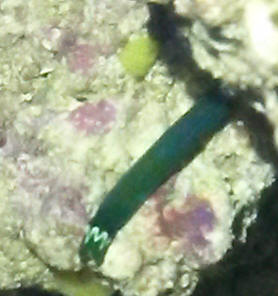 |
|
Identification of Marine Organism
11/22/11
Hello,
I am in need of help in identifying the organism shown in the
attachment of this email. Also included is a map of where it was
found (off the coast of Massachusetts). From what I can tell it
is some type of sea worm, possibly a proboscis worm (Nemertea).
Any information that would help in the Identification of this
organism would be much appreciated!
Thanks,
Erik
<Does appear to be a Nemertean of some sort/species. You'd
do well to send this specimen to a specialist at an east coast
university in the field of worm taxonomy. Bob Fenner>
|
|
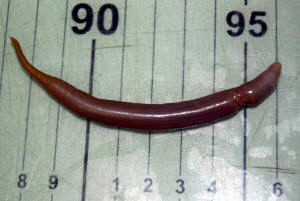
|
|
White worm -- 11/10/09
Bob, I apologize if you did get this email and I am just in too
big a hurry.
<Don't recall ever seeing this>
I can't find any article or picture like this worm. I am very
concerned for my fish. I tried to meet your picture size needs
and hope sending two was not too bad but hope you can determine
what this worm is and if I should remove the rock (major
aquascape project) to protect my pets. Its too skittish and fast
to catch. Trapping hasn't been successful.
It has also been suggested it may be a Polychaetes, Glycera rouxi
(found on your site) but it is white, not brown.
<Come in different colors, shades... are there any bristles on
the side of this worm? Your pix are too poorly resolved to see
much. Take a look on the net for the family Glyceridae>
I don't see where this is "good" or "bad"
for SPS and LPS. I have both.
I see there are several responses dated 11/9/09 but have never
written to you so am possibly just too anxious for your
knowledge.
Thanks, Jolene
<Might be an Errantiate Polychaete... could even be a
Nemertean from the pic:
http://wetwebmedia.com/ribnwrmidfaqs.htm
Bob Fenner>
|
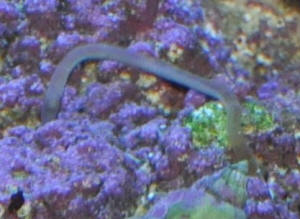 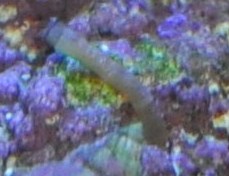 |
Re: white worm --
11/10/09
Your site is awesome. I've read so much about (*&*&(^
worms in the last few days! I don't see any "legs" it
just slithers (partially) out of the rock then nips at it and
quickly retreats back, then out again.
<Ahh! Then doubtful this is a Polychaete (means: "many
bristles")>
Its very thin. It appears it probably has two tentacles at the
mouth end but is so small/short I can't really tell. It
doesn't look like any of the worm pics on your site (or any
other) of any color. Actually, the closest resemblance is from your
site in worm section 4 (I think) under Polychaetes reproductive
comments. But, it has not been swimming freely or floating in the
water column. What do you think?
Jolene
<Nah, not an epitoke... these are very active, as you state, and
rather short lived... and don't generally feed! BobF, who's
sticking with his guess that this is a Ribbonworm for now>
Re: white worm -- 11/11/09
Thank you so much and such fast communications! I will keep a close
eye on it and read more about ribbon worms. It doesn't sound
like they are harmful. I'll try to get a better picture for our
club meeting (11/21) so they can see a better picture than what I
currently have. I'll send to you as well. They are the ones who
introduced me to your site.
I know our club would love to have you a guest if you are ever in
our area (Arkansas).
Jolene
<I do get out and about. Please have your "program
director" designate contact me re. Cheers, Bob Fenner>
Re: white worm -- 11/11/09
I'll pay more attention when the lights go out and try to get a
better picture. I can't get the rock out without disassembling
the tank and don't want to do that unless absolutely necessary
but of course I will if needed.
I feel better that you guys have not said "oh no, its a
>>>> get it out quick"!
<Ahh! I would leave this animal in your system. Are interesting
behaviorally and not damaging given "large enough
systems" which you have>
White and no appendages. Is that "common"?
<Not uncommon>
I can't find an exact picture anywhere but Bob's remarks
and thoughts also sound very reasonable.
<Thought I'd referred you. Please see here:
http://wetwebmedia.com/ribnwrmidfaqs.htm>
How does one become a worm expert?
<Heeee! Study... college courses in invertebrate zoology,
diving, working in sorting and identifying benthic animals for
bioassays.... There are MANY worm groups (phyla) and tens of
thousands of species... all sorts of life styles, feeding modes,
free-living to obligate parasites... tiny to quite huge>
A very "special" person I'm sure! I've not seem
anything like these little worms in the Caribbean where I dive. I
guess they are there, yuk.
Jolene
<Heeeee Heheeee. Just have to be looking closer. Much to see.
Bob Fenner> |
|
Can you Identify This Invertebrate? Possible Nemertean
-- 7 21/09
<Hello Kelly, Lynn here this evening.>
I am in need of your help. It seems nobody has been able to
identify this creature we just noticed in my saltwater tank. He
is about six inches when he stretches out, two maybe when he
shrinks, long and thin, white with thin black stripes. He snakes
slowly around the walls of my tank minding his own business
during the day, we have never noticed him at night. I have
searched the internet and found nothing! I need to know what he
is and if he is reef safe? I'm attaching three pics. He is
stretched out straight
in these.
<Well, it looks a bit like a Nemertean (aka a ribbon worm) but
without detailed photos, I can't be sure. If you have a
magnifying glass, take a close look and see if the worm is
segmented or smooth, and whether it has any legs or appendages on
either side. If it's smooth with nothing on the sides,
chances are good that it's a Nemertean. These worms are
typically long, skinny, mostly carnivorous predators of other
worms, probably amphipods and such. The good news is that when
they do turn up as hitchhikers, they're usually small, stay
that way and don't seem to cause any trouble. I'd leave
the little guy in place and enjoy him.
For more information, please see the following links:
http://www.wetwebmedia.com/ribnwrmidfaqs.htm
Similar Nemerteans:
http://nemertea.lifedesks.org/files/nemertea/images/Picture1.png
By the way, if you rule out a Nemertean, do try to get some good
close-up shots of the head and body and send them on to us.
We'll see if we can't figure out what the little critter
is!>
Thanks, Kelly
<You're very welcome. Take care, LynnZ>
|
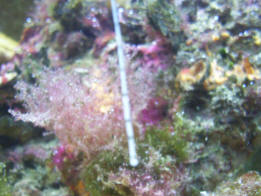 |
|
Re: Can you Identify This Invertebrate?
Possible Nemertean -- Nope, Something Else 7/21/09
<Hello, Kelly>
He is segmented, that's all the more I can tell you at this
time.
<Every bit helps, thanks!>
I will get some better photos and better close-up of his head as
soon as I see him again. He or she as it maybe has a baby
floating around we just found last night.
<Interesting. Some Polychaetes reproduce by way of budding
("stolonization"). That is, breaking off segments of
their body to produce young. I'll be looking forward to
seeing those photos! Take care, LynnZ>
|
|
Long Black Worm: Nemertean -- 8/25/08 Hello Everyone,
<Hi there, Kayren!> This site is GREAT! <Thanks!> You
have helped me identify most of the interesting things I've
discovered living in my 40 gallon tank as a result of using live
rock (about 35 pounds so far - I know I need more). It's been
set up for about 9 months now, and going pretty well. I have an
Emperor filter on the back rated for 80 gallons (containing
filter floss, 2 regular carbon filters, a Poly Filter and one bag
Chemi Pure). <That's a packed filter!> I have a
submersible 7 watt UV sterilizer. I will soon be getting a 350
Magnum Deluxe and a protein skimmer. I'm also using an under
gravel filter with about 3 inches of gravel; crushed coral, I
think. (I found out afterwards that's not particularly the
best way to have gone). <Unfortunately, it's not, but with
proper attention it should be okay. Please see these links (along
with related links at top of page)
http://www.wetwebmedia.com/FWSubWebIndex/ug5proscons.htm
http://www.wetwebmedia.com/u_gfiltmarfaqs.htm > The occupants
at the moment are a Fox Face Rabbitfish, an Olive Tang, a Sailfin
Tang (they get along ok), <Unfortunately, they won't long
term. A forty gallon display doesn't supply enough room for
any one of these fish, let alone all three. They may be okay
right now if they're all very small, but as they grow
they're going to get stressed. When that time comes,
you'll very likely see increased aggression and disease
issues. Please see these links (and related links above):
Rabbitfish/Siganids: http://www.wetwebmedia.com/rbtfshsysfaqs.htm
Tangs: http://www.wetwebmedia.com/tangsysfaqs.htm > ..a
Mandarin Goby, <These are sometimes referred to as gobies,
however they're actually Dragonets. Also, unless it's
eating 'alternative' foods (frozen Mysis, etc),
you're going to need a continual supply of small live
invertebrates (amphipods, copepods). These can be obtained either
through cultivation or purchase. Please see these links (and
related above): http://www.wetwebmedia.com/mandarins.htm
http://www.wetwebmedia.com/mandfdgfaqs.htm > a Yellowtail
Damsel, <Can be mean little suckers!> 5 Green Chromis, 2
Red-leg Crabs, 1 Blue-leg crab; and the occupants this site
helped me to identify: a Brittle Star, Spaghetti Worms,
Stomatellas, Feather Duster Worms, <Nice hitchhikers.> ..as
well as a few others. Question: Is it ever a good idea to just
take out the airlift tubes and stop using the under gravel filter
after it's been set-up, or would the water underneath the
filter just get too yucky? <Could be a problem, but should be
okay. What you'd have would essentially be a 'plenum'
Please see these links (along with related links at top of
pages): http://wetwebmedia.com/Plenums.htm
http://wetwebmedia.com/plenumuse.htm > The individual I
encountered two days ago is the one I need your help to identify.
<All right, now we get to the fun stuff!> I searched the
site, but didn't find anything that sounded like it. I was
using a new gravel vac (actually an Eheim Sludge remover that
works really well). Shortly thereafter I noticed this LONG black
worm in the gravel, but visible because it was pressed up between
the glass and the gravel on the side. It looked similar to an
earthworm, but without the middle part. It looked to be between
1/4 - 1/2 inches wide, perhaps about 1/2 inch in girth, and the
part that I could see was about 6 inches long; I never saw the
end but I could tell the worm continued past the part I could
see. It didn't look like it had any legs; and what I assumed
was the head portion could have been about 1/2 inch long, and
looked comparable to something being wrapped in cellophane tape
(maybe it's a 'tape' worm! lol). <Heheee!>
After moving around a bit, it moved deeper into the gravel, but I
think it's still near the glass because I think I can still
see parts of it. Anyway, your expert opinion would be greatly
appreciated. <LOL Well, I'm hardly an expert, but I'll
offer my opinion anyway! Your mystery creature looks like a
harmless Nemertean, or Ribbon worm. Please see these links for
photo comparison and more information:
http://www.wetwebmedia.com/ribnwrmidfaqs.htm
http://www.chucksaddiction.com/hitchworms.html> I've
attached a picture taken in the macro setting. <That's
wonderful, thank you.> Thanks. (My apologies if the picture is
more than a few hundred Kbytes). Kayren <You're very
welcome. Take care, -Lynn>
|
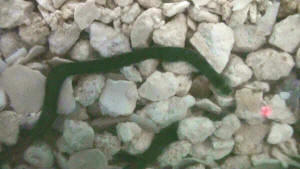 |
| What Is This Worm? A Nemertean! 7/28/08
<Hi there, Wendy.> Can you identify this animal? <Yes,
it's a beautiful little Nemertean (Phylum Nemertea, likely a
species in the genus Notospermus), aka a Ribbon worm. Please see
this link for more information/photos regarding:
http://www.wetwebmedia.com/ribnwrmidfaqs.htm> Fully stretched
out it was about 4-5' long (I tore it apart accidentally when I
pulled it out of the rock that it was in) <Woops!> Please
help. Thanks, Wendy <No worries, you should be good to go! Take
care, -Lynn> |
|
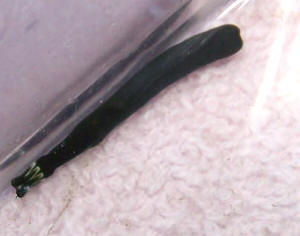
Re: What Is This Worm? A Nemertean! 7/28/08
<Hello again, Wendy!> Thank you so much for your help.
<You're very welcome.> I looked through this link it
seems that it will be okay to keep it in my tank. But I would
like to know what it eats. I have searched several areas and
can't seem to find what it eats. <Small invertebrates,
likely amphipods and such would be my guess. Nemerteans are
predators and scavengers, and although some varieties can get
very long indeed, the ones we usually run across (such as yours)
seem to cause no significant negative impact on the livestock
within the particular system.> Thanks again Wendy <It was
my pleasure. Take care, -Lynn>
|
|
Blue Ribbon Worm? 2/1/06
Hi Guys, <Robin> Before I ask my question I just want to
say, you guys are awesome and this has got to be the best site in
the Web for fish keepers! <Thank you for your kind words>
In the last 6 months I've gone from keeping single 150g Loach
tank to adding a 75g reef tank to my apartment. Moving slowly, I
now have a handful of fish, a couple of coral frags (a thick
branch pink birds nest and an amethyst Porites) and recently
added some more live rock. Along with the rock I appear to have a
brand new hitchhiker. I caught a glimpse of him this morning just
before lights on. I ran and grabbed the digital camera and
managed to get a couple of good photos of him. <Very nice>
After searching your site I've come to suspect he may be some
sort of ribbon worm. <Yes... does appear to be a Nemertean>
But the photos we not terribly clear so I'm not totally sure
(feel free to use any of these photos in the worm ID section if
you like). He's a beautiful navy blue color with a jagged
white stripe on his head and appears to be velvety in texture. If
he is a ribbon worm, any idea what species he is, if he poses a
hazard to anyone else in the tank and what he eats? <Can't
identify to species... looks like a Notospermus species though...
widely distributed throughout the tropical Indo-Pacific>
He's one cool looking critter, so if he's a harmless
I'd like to try and keep him alive and healthy. Thanks in
advance for your help and for such a fantastic site! Robin <I
would definitely try to keep this animal about. A beauty. Bob
Fenner>
|
|

Ribbon Worm Update 12/27/11
Hello WetWebMedia Crew,
<Robin>
Way back in February 2006 you helped me identify
a hitchhiker I had as a ribbon worm.
<Ah yes, I do recall>
He's actually the poster worm for the ribbon worm page on WWM
(
http://www.wetwebmedia.com/ribnwrmidfaqs.htm
) and my original post is 3rd from the bottom of
the page. In the intervening years I was able to identify the
species as Notospermus tricuspidatus. They are secretive critters
and apparently nocturnal so he was a rare sight in the tank and
lately I hadn't seen him in quite some time.
Thanks to a recent move I had occasion to remove all my live rock
and transfer it to a new tank. Guess who I found poking his head
out of a hole in the live rock tonight but my beautiful blue
ribbon worm! Nearly six years later - despite one tank crash and
some less than ideal husbandry at times - he's still happily
living in my tank. Since there is not much information on these
creatures - certainly not their longevity - I thought I would
share this with you. He's been a model citizen all these
years so I encourage anyone else who is lucky enough to find a
ribbon worm in their tank to let it be and enjoy this interesting
animal.
Robin
<Thank you for this delightful follow-up. Bob Fenner>
|
| Possible Sea Snake in Reef Tank Hi Bob,
<Howdy> I wouldn't bother you if it weren't important
to determine whether or not I have a sea snake in my reef tank. I
had to tear down and move my 72-gallon bow front for a new carpet
installation, and in the process came across what I believe but
hope isn't a sea snake protruding from a rock. I've
attached 3 digital pictures I took so you can get a look. You
probably can't see it well in the pictures, but on the
"head" end, there are white diamond-shaped markings all
the way around. I have to tear this tank down again in a couple
days after the carpet is installed and return it to its permanent
location, and needless to say, I'm a bit "tank shy"
after encountering this critter. It didn't come completely out
of the rock, but as you can see in the pictures, it's well over
a foot long without coming all the way out. Also, when it was
"standing," the neck appeared to widen and "flatten
out" as would a Cobra or some type of snake that stands like
that. <Neat... you appear to be the not-so-proud owner of a
Ribbonworm (Phylum Nemertea). Not to worry re... it will not harm
you or your livestock. Please see here: http://www.wetwebmedia.com/worms.htm>
Your prompt (or even better - immediate!) response would be greatly
appreciated. I hope to learn this is some harmless animal that does
not need to be removed. <I would do my best to not disturb the
system too much in moving... drain the water out, move tank, put
the water back in. This animals presence is tribute to your good
husbandry. Bob Fenner> Peggy |
 |
Snake in Reef?! Bob, <Peg> Many thanks for your very
prompt response to my e-mail regarding the snake-like critter in my
system. This is one worm I surely was not familiar with, and am I ever
glad he's a worm and nothing worse!! Now I won't have the fear
of God in me when I tear down again to return the tank to the living
room. I also thank you for the compliment regarding husbandry. I live
for all my gifts from the sea! <Ahh, a gracious statement> Thanks
again, <Glad to share. Bob Fenner> Peggy
Re: Possible Sea Snake in Reef Tank Hi Bob, <Hello Peggy, good
morrow> Many thanks for your prompt response. I'm happy to know
this beautiful animal is harmless and also that my husbandry has
contributed to its well-being. They surely have the appearance of a
snake when they stand! I don't look forward to tearing down yet
again to move the tank back to the living room, but one must do what
one must do. That will be its last move for a very long time! <Do
enjoy the process. Bob Fenner> Peggy
|
|

